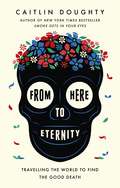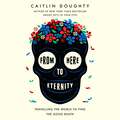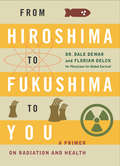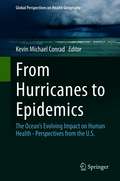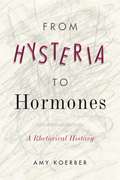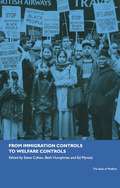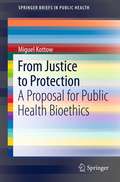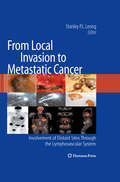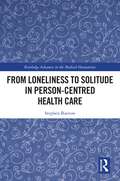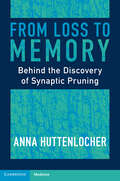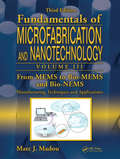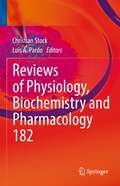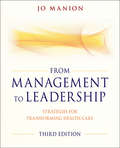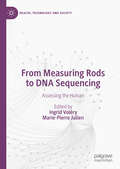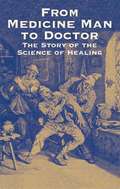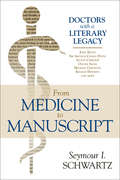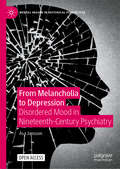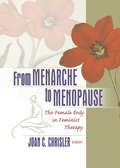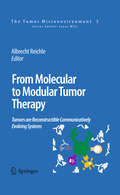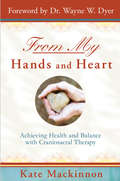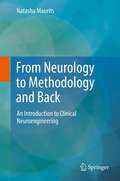- Table View
- List View
From Here to Eternity: Travelling the World to Find the Good Death
by Caitlin DoughtyAs a practising mortician, Caitlin Doughty has long been fascinated by our pervasive terror of dead bodies. In From Here to Eternity she sets out in search of cultures unburdened by such fears. With curiosity and morbid humour, Doughty introduces us to inspiring death-care innovators, participates in powerful death practices almost entirely unknown in the West and explores new spaces for mourning - including a futuristic glowing-Buddha columbarium in Japan, a candlelit Mexican cemetery, and America's only open-air pyre. In doing so she expands our sense of what it means to treat the dead with 'dignity' and reveals unexpected possibilities for our own death rituals.
From Here to Eternity: Travelling the World to Find the Good Death
by Caitlin DoughtyAs a practising mortician, Caitlin Doughty has long been fascinated by our pervasive terror of dead bodies. In From Here to Eternity she sets out in search of cultures unburdened by such fears. In rural Indonesia, she observes a man clean and dress his grandfather's mummified body. She meets Bolivian ñatitas (cigarette-smoking, wish-granting human skulls), and introduces us to the Japanese ritual of kotsuage, in which relatives use chopsticks to pluck their loved-ones' bones from cremation ashes. With curiosity and morbid humour, Doughty introduces us to inspiring death-care innovators, participates in powerful death practices almost entirely unknown in the West and explores new spaces for mourning - including a futuristic glowing-Buddha columbarium in Japan, a candlelit Mexican cemetery, and America's only open-air pyre. In doing so she expands our sense of what it means to treat the dead with 'dignity' and reveals unexpected possibilities for our own death rituals.Read by Caitlin Doughty(p) 2017 Recorded Books LLC
From Hiroshima to Fukushima to You: A Primer on Radiation and Health
by Florian Oelck Dale DewarThe bombing of Hiroshima on August 6, 1945, brought radiation to international attention but the exact nature of what had been unleashed was still unclear to most. The 1986 meltdown at the Chernobyl nuclear plant again made headlines with estimates of fatalities ranging from 4000 to almost a million deaths. By the time of the shocking 2011 disaster at the Fukushima nuclear plant social media meant governments and corporations no longer had a monopoly over the release of information, but transparency remains low on the agenda. Meanwhile, few physicians give thought to the delayed health effects of radiation. It has been the bold physician who has challenged the potential overuse of chest X-rays, CT scanning, or PET scans. This book provides clear and accurate information about radiation so that we can all make informed choices. In clear language it offers answers to citizens’ questions: What is radiation? Where do we encounter it? What are the benefits and risks? How do we develop a responsible future around the uses and abuses of radioactivity?
From Hurricanes to Epidemics: The Ocean's Evolving Impact on Human Health - Perspectives from the U.S. (Global Perspectives on Health Geography)
by Kevin ConradThis book provides a complete and current overview of the correlation between ocean conditions and human health, publishing comprehensively for the first time on the direct interactions among oceanography, marine biology and impacts on human health. Specifically the text addresses how changing ocean conditions result in health impacts and disruptions, with a focus on cases in the USA. The changing ocean conditions that are discussed include diminishing marine biodiversity, climactic changes such as intensified weather events, shifting sea currents and increasing sea temperature. The book addresses the resulting health issues brought about by these various ocean conditions, such as emerging infectious diseases, starvation and poisoning among impacted communities, toxic algae blooms, threatened ecosystems, and other future implications. The text was developed in conjunction with scientists from Brown University, the University of Rhode Island, the University of Texas at Austin, the University of California at Riverside and Ochsner Health, all located in areas deeply impacted by the changing Oceans. The book will be of interest to marine research scientists, health care professionals, students, and general enthusiasts of oceanography and health.
From Hysteria to Hormones: A Rhetorical History (RSA Series in Transdisciplinary Rhetoric #7)
by Amy KoerberIn From Hysteria to Hormones, Amy Koerber examines the rhetorical activity that preceded the early twentieth-century emergence of the word hormone and the impact of this word on expert understandings of women’s health.Shortly after Ernest Henry Starling coined the term “hormone” in 1905, hormones began to provide a chemical explanation for bodily phenomena that were previously understood in terms of “wandering wombs,” humors, energies, and balance. In this study, Koerber posits that the discovery of hormones was not so much a revolution as an exigency that required old ways of thinking to be twisted, reshaped, and transformed to fit more scientific turn-of-the-century expectations of medical practices. She engages with texts from a wide array of medical and social scientific subdisciplines; with material from medical archives, including patient charts, handwritten notes, and photographs from the Salpêtrière Hospital, where Dr. Jean Charcot treated hundreds of hysteria patients in the late nineteenth century; and with current rhetorical theoretical approaches to the study of health and medicine. In doing so, Koerber shows that the boundary between older, nonscientific ways of understanding women’s bodies and newer, scientific understandings is much murkier than we might expect.A clarifying examination of how the term “hormones” preserves key concepts that have framed our understanding of women’s bodies from ancient times to the present, this innovative book illuminates the ways in which the words we use today to discuss female reproductive health aren’t nearly as scientifically accurate or socially progressive as believed. Scholars of rhetoric, gender studies, and women’s health will find Koerber’s work provocative and valuable.
From Immigration Controls to Welfare Controls (The\state Of Welfare Ser.)
by Steve Cohen Beth Humphries Ed MynottThis edited collection addresses theoretical, political and practical aspects of the connection between external immigration controls and internal welfare controls. It considers the implications for the both those subject to controls and those drawn into the web of implementing internal welfare controls. Topics discussed include:* forced dispersal of asylum seekers* local authority and voluntary sector regulations* nationalism, racism, class and 'fairness'* strategies for resistance to controls* USA controls.The book provides support to those unwittingly drawn into administering controls, showing how the role of welfare workers as immigration control enforcers is not a sudden imposition but has exisited since the introduction of controls in 1905.From Immigration Controls to Welfare Controls will provide a valuable resource for all those professionals who come into contact with the issues surrounding immigration.
From Justice to Protection
by Miguel KottowIn most developed countries, the epidemiological disease profile has changed from infectious to degenerative, causing major alterations in epidemiological thinking and public health policies. Less developed nations have to deal with a more complex situation, because social disparities create highly unequal health conditions, the affluent being afflicted by degenerative conditions, whereas the poorer social segments continue to suffer infectious diseases, but also begin to feel the effects of chronic illness. At the turn of the 21st century, equity in health care is not being served, and social justice has lost credibility as a conceptual driving force of public health policies. Rampant injustice confirms that theories, reality and suggested practices of just social orders are flawed, leaving the needy without help or hope in a world of flagrant ethical inadequacy. And yet, mainstream bioethics loses meaning and relevance as it clings to the principle of justice and hails such concepts as global justice and universal health-care equity, misleadingly focusing on justice as a desideratum. This book pleads for an urgent turn towards directly addressing injustice as a reality that requires pressingly needed arguments and proposals to inspire realistic public health policies and programs based on an ethics of protection. Ever since Hobbes, all shades of political philosophy accept that the basic obligation of the ruling power is to protect its subjects. The ethics of protection emphasizes aiding the needy and the disempowered in obtaining access to basic goods and services related to health-care. Public health is called upon to fulfill protective obligations to guarantee disease prevention and medical services to the population, taking special care to safeguard those unable to cover their health-care needs in market-oriented medical services and institutions. The bioethics of protection developed in this text presents specific and explicit guide-lines to assure that protective public health actions be efficacious (problem-solving), efficient (sustainable cost/benefit relation) and ethically sound (respecting human rights and the common weal). These guide-lines are designed to give ethical support and justification to public health policies even when they require some unavoidable limitations of individual autonomy to promote social health benefits.
From Local Invasion to Metastatic Cancer
by Stanley P. LeongIn human solid tumors, nodal status is the most important prognostic indicator for patient outcome. Recent developments in the sentinel lymph node concept have resulted in new procedures to define the first draining node as the primary gateway through which the cancer will spread. In From Local Invasion to Metastatic Cancer: Involvement of Distant Sites Through the Lymphovascular System, a panel of international authorities takes an in-depth look at the role of the lymphovascular system in the spread of cancer. The authors summarize the findings of the Second International Symposium on Cancer Metastasis: Basis for Rational Therapy summit. Specifically, the book presents important developments in the biology and clinical understanding of cancer metastasis, describes the relationship between tumor microenvironment and proliferation, and defines the process of lymphangiogenesis and angiogenesis with special reference to cancer metastasis. From Local Invasion to Metastatic Cancer: Involvement of Distant Sites Through the Lymphovascular System provides oncologists, radiologists, and cancer researchers the necessary information to study and develop new strategies to curb the process of metastasis.
From Loneliness to Solitude in Person-centred Health Care (Routledge Advances in the Medical Humanities)
by Stephen BuetowThis innovative book provides a new conceptual analysis of loneliness – a condition associated with severe health consequences, including increased morbidity and early death. Arguing that social connection is not the only answer, it explores pathways for transforming loneliness to healthy solitude. The first part of the book draws on the humanities and arts, including psychology, philosophy and literature to analyse the common, and potentially serious, problem of loneliness. It makes the case that the condition is less a deficiency than a state of self-disconnection that modernity feeds through social forces. The second part of the book looks at how person-centred health care can help educate persons to transform loneliness into healthy solitude. It provides an analysis of self-connection and spiritual connection, discussing how these forms of contact can mitigate risks associated with both lack of social connection, and social connection itself, such as self-disconnection and rejection by others. It goes on to demonstrate that connection to the self and spirit can make aloneness a resource and facilitate access to benefits of connecting with others. This thought-provoking book provides students, scholars and practitioners from a range of health and social care backgrounds with a new way of thinking about, researching and practising with lonely people.
From Loss to Memory: Behind the Discovery of Synaptic Pruning
by Anna HuttenlocherHow do the billions of connections between neurons in our brain change as we learn and remember? This is the story of the discovery and the discoverer of synaptic pruning, the process of synapse elimination central to making us who we are. Taking the reader from Professor Peter Huttenlocher's childhood in wartime and post-war Germany to his emigration to the US to reunite with his mother and the launch and progress of a career in medicine and research, we uncover the motivations and process of scientific discovery that led to an unexpected leap in our understanding of the human brain. Decades after the discovery, the importance of synaptic pruning to early learning, autism, schizophrenia, Alzheimer's disease and other conditions are now in the process of being uncovered.
From MEMS to Bio-MEMS and Bio-NEMS: Manufacturing Techniques and Applications
by Marc J. MadouFrom MEMS to Bio-MEMS and Bio-NEMS: Manufacturing Techniques and Applications details manufacturing techniques applicable to bionanotechnology. After reviewing MEMS techniques, materials, and modeling, the author covers nanofabrication, genetically engineered proteins, artificial cells, nanochemistry, and self-assembly. He also discusses scaling la
From Madness To Mental Health: Psychiatric Disorder And Its Treatment In Western Civilization
by Greg Eghigian Gail HornsteinFrom Madness to Mental Health neither glorifies nor denigrates the contributions of psychiatry, clinical psychology, and psychotherapy, but rather considers how mental disorders have historically challenged the ways in which human beings have understood and valued their bodies, minds, and souls. Greg Eghigian has compiled a unique anthology of readings, from ancient times to the present, that includes Hippocrates; Julian of Norwich's Revelations of Divine Love, penned in the 1390s; Dorothea Dix; Aaron T. Beck; Carl Rogers; and others, culled from religious texts, clinical case studies, memoirs, academic lectures, hospital and government records, legal and medical treatises, and art collections. Incorporating historical experiences of medical practitioners and those deemed mentally ill, From Madness to Mental Health also includes an updated bibliography of first-person narratives on mental illness compiled by Gail A. Hornstein.
From Malignant Transformation to Metastasis: Ion Transport in Tumor Biology (Reviews of Physiology, Biochemistry and Pharmacology #182)
by Christian Stock Luis A. PardoThis second book of the three-volume collection "Ion Transport in Tumor Biology" helps readers gain comprehensive knowledge of the pathophysiology of cancer. The authors highlight that ion transport proteins, channels and transporters - collectively referred to as the transportome - are significantly involved in the development and progression of cancer. Nearly 90% of malignant tumor diseases originate from epithelial cells, the function of which, for the most part, is based on the transportome. This volume focuses on molecular principles by showing that dysregulated expression and/or function of ion transporters have been correlated with malignancy in the vast majority of tumor diseases.Within the story of the various chapters, the authors line out various malfunctions of the transportome and where they can be found at different stages of the metastatic cascade. The authors describe how the interactions between the tumor cells' transportome and the environment reinforce mesenchymal behaviour of cancer cells and contribute to their uncontrolled proliferation, migration, invasion, intra- and extravasation up to the formation of metastases. As part of a three-volume collection, this book will fascinate members of the active research community, as well as clinicians from the cancer field.
From Management to Leadership
by Jo ManionFrom Management to Leadership identifies the fundamental interpersonal skills that every health care leader (and aspiring leader) needs to develop in order to be a successful executive or manager. The third edition of the classic text offers suggestions for developing and improving essential health care leadership skills. Written to be a practical guide, the book presents concepts and skills that can be immediately applied to everyday situations. Completely revised and updated, this edition includes new concepts and resources based on the latest research and practices. Praise for the Third Edition of From Management to Leadership "As leaders, we want engagement, commitment, ownership, teamwork, and results. Jo Manion illuminates the interpersonal skills that are pivotal. She provides the how in a way that's convincing, refreshing, mind-stretching, and practical. " -Wendy Leebov, EdD, president, Wendy Leebov and Associates "This third edition continues the tradition of enumerating the incisive and articulate response of leaders to the complexities of the age and of the necessary recalibration of the leader's role. I encourage contemporary leaders to see this text as a must have in their leadership library: I certainly have it in mine!" -Tim Porter-O'Grady, DM, EdD, ScD(h), APRN, FAAN, senior partner, Tim Porter-O'Grady Associates, Inc. and associate professor, College of Nursing and Health Innovation, Arizona State University "Finally, a book that addresses the need for health care leaders and aspiring leaders to be much more than good managers. This book gives practical, concrete, and insightful strategies to becoming a great leader. " -Katherine W. Vestal, RN, PhD, FACHE, FAAN, president, Work Innovations LLC Companion Web site: www. josseybass. com/go/manion
From Measuring Rods to DNA Sequencing: Assessing the Human (Health, Technology and Society)
by Ingrid Voléry Marie-Pierre JulienThis book provides a solid basis to understand two centuries of bodily measurement practices and their scientific and political scope throughout the Western world. By exploring various cases, it proposes a new approach of measurement from an epistemological point of view and demonstrates the central role of the measurement of the body for political purposes. By studying categorizations of race, age and quality of life between the 19th and 20th century, the first part of the book highlights how human body measurements extend from the flesh to subjective experience. The second part shows how genomic correction and life support technologies reshape the frontiers between things, humans and social subjects. The final part reveals how contemporary measurements of age, race and disease gave rise to new hierarchies between human beings and social groups. The book concludes by considering different styles of measuring the body and their ontological consequences.
From Medicine Man to Doctor: The Story of the Science of Healing
by Howard W. HaggardCompelling and informative, this overview of medical history traces modern-day medical practices from their roots in the ancient civilizations of Egypt, Greece, and Rome. Physician Howard W. Haggard — a popular lecturer, prolific author, and Yale professor — specialized in explaining health-related issues to ordinary people. This 1929 survey offers fascinating facts and anecdotes from around the world in its chronicles of the development of obstetrical methods, anesthesia, surgery, drugs, and other landmarks in the science of healing.The first chapters examine the treatment of child-bearing women throughout the centuries, from practices related to the legends of Aesculapius and Hygeia to the long battle against puerperal fever, the invention of obstetrical forceps, and the rise of anesthesia. A profile of the progress of surgery explores the violent opposition to early attempts at studying anatomy through human dissection, and the gradual adoption of antiseptic principles. Quarantine, vaccination, and a heightened public awareness are cited among the record of attempts to conquer plague and pestilence.Final chapters investigate faith healing through the ages and occult practices such as exorcism and the trade in holy relics; herb doctors and medieval apothecaries; the recognition of bacteria as a cause of infectious disease; and the eventual trend away from treatment and toward prevention.
From Medicine to Manuscript: Doctors with a Literary Legacy
by Seymour I. SchwartzAn eminent surgeon, who has written books on the history of medicine and cartography, profiles physicians past and present who have also published works in the humanities.Throughout history doctors have felt the need to express themselves in prose and poetry, often on subjects far removed from their medical interests. Renowned surgeon Seymour I. Schwartz felt this same compulsion to write and eventually decided to investigate other authors with a background in medicine. The result is this informative and entertaining compilation of biographical profiles spanning the Middle Ages to the present era.In many cases, literary fame has eclipsed memory of these authors' medical expertise: Most people today talk about Maimonides, Rabelais, Locke, Schiller, Keats, Conan Doyle, and Chekhov because of their literary works, not because they practiced medicine. But the lesser-known individuals are just as interesting in many ways: such people as Cadwallader Colden, the loyalist lieutenant governor of New York during the American Revolution, who wrote the first English history of the Iroquois; Margaret Georgina Todd, author of popular novels in the Victorian era, which promoted the idea of women in medicine; and Rudolph John Chauncey Fisher, who was not only a physician, researcher, and radiologist, but played a role in the Harlem Renaissance as an orator, musician, musical arranger, and literary figure.Concluding with profiles of contemporary doctors who are also respected authors, this diverse collection shows that, despite increasing specialization, medicine and the humanities continue to complement each other to enrich our lives.
From Melancholia to Depression: Disordered Mood in Nineteenth-Century Psychiatry (Mental Health in Historical Perspective)
by Åsa JanssonThis open access book maps a crucial but neglected chapter in the history of psychiatry: how was melancholia transformed in the nineteenth century from traditional melancholy madness into a modern biomedical mood disorder, paving the way for the emergence of clinical depression as a psychiatric illness in the twentieth century? At a time when the prevalence of mood disorders and antidepressant consumption are at an all-time high, the need for a comprehensive historical understanding of how modern depressive illness came into being has never been more urgent. This book addresses a significant gap in existing scholarly literature on melancholia, depression, and mood disorders by offering a contextualised and critical perspective on the history of melancholia in the first decades of psychiatry, from the 1830s until the turn of the twentieth century.
From Menarche to Menopause: The Female Body in Feminist Therapy
by Joan ChrislerFrom Menarche to Menopause: The Female Body in Feminist Therapy examines the latest research on the menstrual cycle and women&’s reproductive health. This timely volume focuses on women in therapy who are disconnected from-or even repelled by-their own bodies due to cultural attitudes, abuse, trauma, or the natural aging process. Experts in the fields of psychology and women&’s health unite to celebrate the physical life stages of women and girls and to offer practical advice for therapists to use when addressing negativity caused by appearance, age, menstrual symptoms, or reproductive concerns. In this book, you will gain new understanding about the effects on a woman&’s mental health that transitional life stages can cause, from preadolescence through the childbearing years to menopause. The suggestions in From Menarche to Menopause can help women resist the bombardment of negative messages and misleading information they receive about their bodies and their reproductive concerns. This helpful resource can also assist you in opening new lines of communication between mothers and daughter, women and men, and women and other women. From Menarche to Menopause discusses how to handle topics such as: self-loathing caused by media and cultural messages that affect women&’s acceptance of their bodies overcoming a daughter&’s reluctance to discuss sensitive topics of bodily maturation, menstruation, and emerging sexual development helping women, men, and couples cope with infertility assisting women in overcoming a disappointing birth experience providing therapeutic care to women and couples who experience perinatal loss addressing perimenopause in midlife women and the concerns, negative attitudes, and uncertainty of this transition This unique book fills the gap in feminist therapy literature with practical advice concerning the functions of women&’s bodies that can be used within the therapy context. From Menarche to Menopause includes extensive references and several book reviews to further your research and provide reading and other resources you can recommend to your clients. This practical resource on women&’s reproductive health-as it relates to mental health-is an important addition to the bookshelves of feminist psychologists, clinical practitioners, social workers, and health practitioners as well as faculty and students of these disciplines.
From Midwife to Mommy (Harlequin Lp Medical Ser. #Vol. 1038)
by Deanne AndersThe family she’s always wanted…With the man she doesn’t expect!Midwife Lana Sanders is about to adopt little Maggie, and gain the family she never thought she’d have, when pediatrician Trent Montgomery arrives claiming to be Maggie’s uncle! Lana won’t give up without a fight, but resisting the tempting Texan is her greatest battle. They work well together in the delivery room and sparks fly in the bedroom, but can Lana trust Trent with her heart?
From Molecular to Modular Tumor Therapy:
by Albrecht ReichleThe traditional problem of the poor presentability as well as diagnostic and therapeutic practicability of individual patient care is still unresolved. The present book aims at leading the reader (cancer researchers, pharmacologists, biologists) away-in a scientifically accessible manner-from the daily conflicts between theory and practice and between the generalized and individual tumor patient, so that more personalized diagnostic and therapeutic strategies can be developed for controlling metastatic tumor disease: * First, recording the systems concept of tumor biology based on rather different sciences (biochemistry, cell biology, and medical oncology) including their potential contribution to communication, * then, giving reductionistically derived systems features an internal communicative context (formal-pragmatic communication theory), and * finally, binding the systems features to (tumor-immanent) evolutionary processes (modularity of biochemical and cellular processes,rat.
From My Hands and Heart: Achieving Health And Balance With Craniosacral Therapy
by Kate MackinnonCraniosacral therapy (CST) is a powerful hands-on treatment that supports the body's own wisdom and innate ability to heal. Tens of thousands of practitioners around the world can attest to the effectiveness of this rapidly growing therapy. In From My Hands and Heart, Kate Mackinnon interweaves her personal journey of using CST with case studies and detailed, easy-to-understand explanations of the theory behind it. Whether you've never heard of CST before, thought it didn't apply to you, or are currently undergoing treatments, this book has something for you. Mackinnon guides you through creating a team of practitioners focused on your well-being, and explains how to help yourself at home between sessions. You'll learn simple, safe techniques that almost anyone can perform and receive. Most important, you'll gain a deeper understanding of the amazing powers of the human body and how, with individualized support through CST, it can find its own way to balance and health.
From Neurology to Methodology and Back
by Natasha MauritsIn today's hospitals, the gap between technology and medicine constantly needs to be bridged, both by physicians and engineers. By taking a unique clinical neuroengineering approach, From Neurology to Methodology and Back offers a translational study of neurology and technology from both sides. The fundamental topics covered range from basic concepts such as sampling and simple statistical measures via Fourier analysis to source localization. Providing clinically relevant context and introduce technical concepts, the neurological diseases presented range from epilepsy, brain tumors and cerebrovascular diseases to tremor, MS and neuromuscular diseases. All topics are presented in a true clinical neuroengineering approach. Each chapter begins with one or more patient cases for inspiration. Each case is then presented to illustrate a working example of a distinct neurodiagnostic technique, and the mathematical and physical principles underlying these techniques are explained. Finally, the author returns to the patient, and examines how the presented technology can help provide a diagnosis for each case. From Neurology to Methodology and Back serves as an upper-undergraduate/graduate level guide for those interested in a translational approach between the fields of medicine and technology in neuroengineering. Neurologists and residents in neurology, medical engineers, medical students, biomedical engineers and students, technical medicine students or students of other interdisciplinary fields will therefore all find this book useful. Each chapter begins with one or more patient cases for inspiration. Each case is then presented to illustrate a working example of a distinct neurodiagnostic technique, and the mathematical and physical principles underlying these techniques are explained. Finally, the author returns to the patient, and examines how the presented technology can help provide a diagnosis for each case. From Neurology to Methodology and Back serves as an upper-undergraduate/graduate level guide for those interested in a translational approach between the fields of medicine and technology in neuroengineering. Neurologists and residents in neurology, medical engineers, medical students, biomedical engineers and students, technical medicine students or students of other interdisciplinary fields will therefore all find this book useful.
From Now Until Forever
by Rowan Coleman'A writer I'd follow anywhere' KATIE FFORDEFrom the Sunday Times bestselling author of The Memory Book, an unforgettable, beautiful novel about what it means to live to the fullest and to love forever.He's running out of time.Ben Church has never done anything extraordinary in his life -- until now. Now, he needs to fulfil as many of his dreams as possible while he still can.That's why he's standing in front of his favourite painting by Leonardo da Vinci when he should be at work. Time is all she has.Vita Ambrose's life of parties and fabulous clothes looks wildly glamorous but in reality it has no meaning. She's seen too much, lived too much and lost too much. That's why she's come back to the gallery, to seek solace in her favourite painting.Together, can they make time stand still? Ben and Vita's connection is immediate, spontaneous and passionate. But the clock is ticking. Can they find a way to make their love live forever? Because every moment matters when it might be your last . . .(P)2023 Hodder & Stoughton Limited
From Now Until Forever
by Rowan Coleman'A time-travelling delight' EVE CHASE'A delightful dream of a book' LISA JEWELL'An incredible story of love and hope' KATIE FFORDE'Gloriously romantic and deeply moving' LUCY DIAMOND'A book you will carry with you long after the last page' MILLY JOHNSON'Up there alongside The Time Traveler's Wife' CAROLE MATTHEWSFrom the Sunday Times bestselling author of The Memory Book, an unforgettable, beautiful novel about what it means to live to the fullest and to love forever, for fans of The Time Traveler's Wife, Me Before You and Outlander.He's running out of time.Ben Church has never done anything extraordinary in his life - until now. Now, he needs to fulfil as many of his dreams as possible while he still can.Time is all she has.Vita Ambrose's life of parties and fabulous clothes looks wildly glamorous but in reality it has no meaning. She's seen too much, lived too much and lost too much.Together, can they make time stand still? Ben and Vita's connection is immediate, spontaneous and passionate. But the clock is ticking. Can they find a way to make their love live forever? Because every moment matters when it might be your last . . .MORE PRAISE FOR FROM NOW UNTIL FOREVER'Beautiful' LOUISE BEECH'Life-affirming and joyful' SARA SHERIDAN'Wonderful . . . both emotional and utterly captivating' JILL MANSELL'A stunning book about what it takes to be truly alive' JULIE COHEN'Captivating and completely unforgettable, Vita and Ben's love story made me believe the impossible might not be so far out of reach' JULIETTA HENDERSON'A fabulous, heart-breaking, uplifting love story that just goes to show time might not always be on our side, but love always wins out.' DAVID BARNETT
